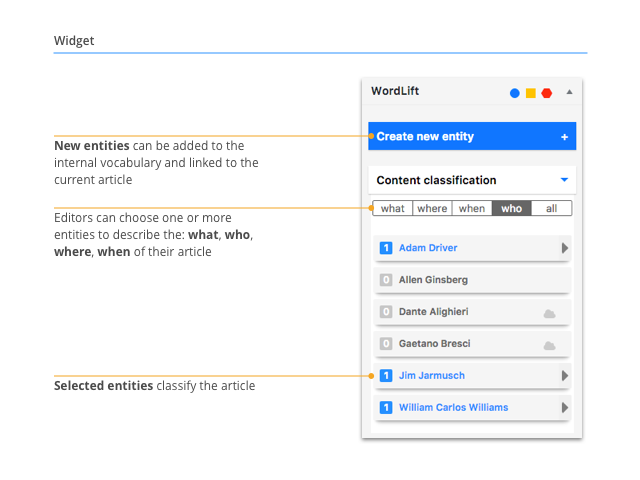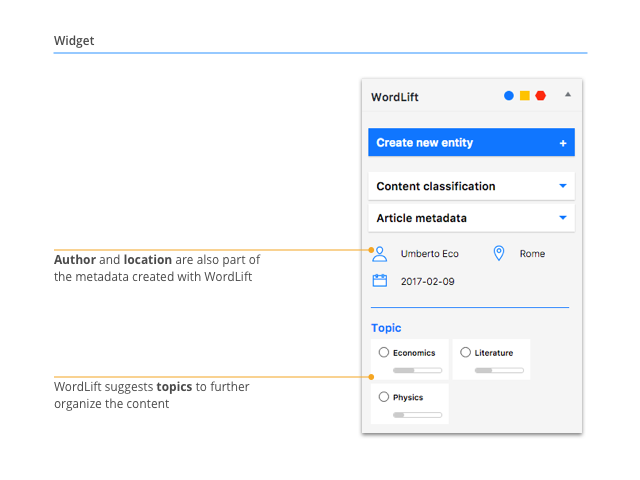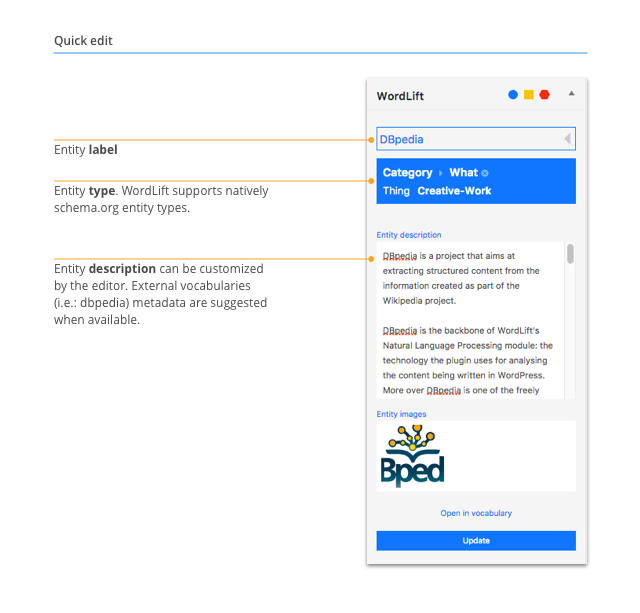Key Concepts
Here is the terminology describing the core concepts that will help you set up and manage your content with WordLift:
Entity
An entity (or thing) is something that exists in the real-world: celebrities, cities, sport teams, buildings, geographical features, movies, celestial objects and works of art are all entities. For a long time, more than four decades, we've been teaching computers to recognise things by simply matching keywords.
Now computers, just like humans do, understand that a text like [Thubten Gyatso] is not just made of two words but, it has a much richer meaning. [Thubten Gyatso] is a person, more specifically he's the 13th Dalai Lama who was born in the Tsang-Ü province in Tibet on the 12th of February 1876.
All this information - collectively shared in public sources like Wikipedia and Freebase - is organised in intelligent models known as Graphs that are helping computers think the way we do and helping us find this information more quickly and even compute it (i.e. providing answers to question like "Was Trinley Gyatso his predecessor?").
Entity Types
Web pages are about many different kind of "things". WordLift uses the Schema.org vocabulary to describe a variety of entity types, each of which has its own set of properties that can be used to describe the entity. The broadest item type is Thing, which has four properties: name, description, url, and image. WordLift supports all the entity types of the schema vocabulary.
Related Entities
In WordLift related entities are primarily the entities being used for annotating a blog post or a page. Each entity we curate can be eventually linked to other entities by running the analysis on its description text. Entities being linked with other entities with the analysis are also known as related entities.
Vocabulary
A vocabulary is a collection of things (or entities).
With WordLift, users can create their own custom vocabulary by creating entities and describing their properties (i.e. [Europe Day] is held on 9 May and celebrates peace and unity in Europe). These entities might already exist in publicly available sources like Wikipedia and Freebase. In this case WordLift provides a list of suggested entities that can be linked to (or reconciled with).
When linking entities to each other, WordLift uses the owl:sameAs property; this means that we're talking about the same thing (or simply that both entities share the same "identity"): "Yes, I'm talking about that same [Europe Day] that Freebase describes with machine id m/04f6ymq".
This linking process is also called [reconciliation] or disambiguation. Find out more on how to import and export the user vocabulary.
Knowledge Graph
A knowledge graph is a network of all kind of entities that are relevant to a specific domain or to an organization. They are not limited to abstract concepts and relations (as with a vocabulary) but also contain the instances of the things they describe.
Using WordLift as new entities are added in the vocabulary, properties for these entities are populated using the ease-to-use WordPress editing interfaces and new posts are enriched with these entities a knowledge graph is created and published as RDF graph in the cloud.
RDF
RDF stands for Resource Description Framework.
RDF is a W3C standard language for representing information.
Linked Open Data
Linked Open Data is Linked Data that is made available as open content. Large linked open datasets (or Knowledge Graph) include DBpedia and Freebase.
Reconciliation
Reconciling entities we store in our own vocabulary with entities available elsewhere provides computers with an unambiguous way to identify the things we're talking about.
[Apple] in a specific article might refer to a rather typical British psychedelic-pop band rather than to a World famous computer company or the forbidden fruit. This becomes important when third party applications like search engines need to provide valuable content for users searching for articles on [Apple] the psychedelic-pop band and not the other two Apples.
Reconciling entities means providing computers with unambiguous identifications of the entities we talk about.
Semantic Fingerprint
The result of semantic annotation of a text is a unique linked identifier added to the HTML code. This identifier is known as semantic fingerprint.
Annotating contents, also known as semantic enrichment or lifting, creates metadata that computers can understand. Just like in forensic science human fingerprints are used to identify humans appearing on a crime scene, in computer science we use semantic fingerprints to tell computers what entities we're referring to.
WordLift re-uses these semantic fingerprints for adding Schema.org markup and for re-purposing contents using Widgets.
Dereferencing HTTP URIs
URI Dereferencing is the process of looking up a URI on the Web in order to get information about the referenced resource. WordLift uses dereferencing to obtain a snapshot of the properties describing a named entity.
Widget
A widget in WordLift is a dynamic visualisation that can be added by the editors to a page via Shortcode or using the WordLift menu.
A Widget is executed by the end-user's browser when accessing a page. A Widget typically displays informations being stored in the knowledge graph and creates dynamic connections between different posts or provides additional information about entities in the post.
WordLift Edit Post Widget
Contents editors using WordLift can identify the basic 'who, what, when and where' of an article and structure information around it by creating new entities in the custom vocabulary. These annotations are added to the posts using the WordLift Edit Post Widget.
Top down post annotation
The content editor, from the list of entities being detected in the text, uses these entities to describe his/her post without selecting any specific text annotations. Entities being selected, in this case, describe the entire post (and not the single occurrence of the entity in the text).

Bottom up entity annotation
The content editor has choosen the “Expo 2015” occurence in the text. In this case, this specific occurrence, is annotated with the entity "Expo 2015".

Edit Entity Properties
The content editor is editing the main properties for the entity "Expo 2015" while writing the post. The complete list of properties can be edited from the Edit Entity page.

Image Suggestor

Images for each entity appear in the WordLift Edit Post Widget and can be dragged and dropped in the visual editor.
WordLift key
The WordLift key is a unique value that is assigned to each user after he/she has subscribed to the WordLift service.
You can now continue to the Analysis page.